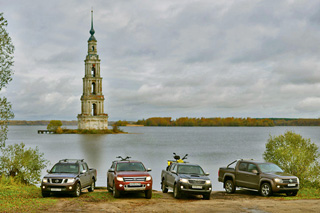Toyota Hilux Single Cab test since 2011 pickup
To the mud to failure
Label horses are gradually transformed into utilitarian cars for outdoor activities, Hilux remained workers and peasants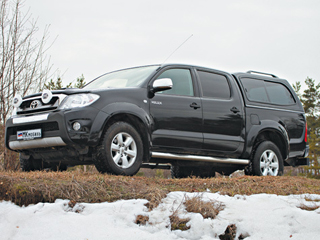
Toyota Hilux? It is very interesting, despite the fact that for some reason, for some reason, they have been pouring at the pickups of us suddenly often often. Before that, however, it would be worth deciding what it is: a working truck or an already utilitarian SUV designed for notorious extremes? VW Amarok, Nissan Navara and even Mitsubishi L200 (in its current incarnation) seemed to be made for the latter, the new Ford Ranger and Mazda BT-50, according to rumors, also evolve, Toyota and cards in hand, but
But Hilux for some reason remained a farm truck. Although why did you stay? It has always been like that, the current version has been made from the first years of the current century. Think about it: all over the world then only learned the name of the second president of Russia, and this car has already stormed rural lands with might and main. Now they brought us a restyled version. So why would this pickup change orientation?

The utilitarian truck should be utilitarian in everything. Therefore, the console is a simple climate block and not too comfortable radio.

Such a panel of instruments in pickups does not look quite appropriate. It looks especially funny on the scales. But this is almost the only original detail in the interior.
It looks like a truck and is made like a truck: large, solid and iron, with a double cabin traditional for us, a rather utilitarian salon and a relatively convenient second series of seats. There is nothing more about him, since the rest of the trunk (more precisely, the cargo compartment, where, for example, two sets of 19-inch wheels or three or four bicycles climbs). However, its capacity is still better to measure potatoes in more familiar bags for us, since it is precisely them in this machine should be carried.
And it will be better if you begin to carry them constantly. Hilux is magnificent. The top 3-liter turbodiesel accelerates relatively well. It makes noise, however, pretty, but in general, the dynamics provides decent. Interestingly, contrary to expectations, the box does not spoil the impression at all, on the contrary, switches on time, moreover, both in the other direction. A idyllic picture, isn't it? But all this works as it should only when you move along a normal, wire and do not exceed the installed traffic rules of speed limits. Up to 100 km/h the pickup does not go, but floats, smoothly swinging the body. Sometimes people with a weak vestibular apparatus in it sometimes even rocking it before that, however, it is worth throwing a certain amount of junk into the body so that the feed does not jump on the bumps. In this case, the Hilux will cut the space with the phlegmaticness of the dry cargo clogged under the waterline, measuredly rolling in corners.
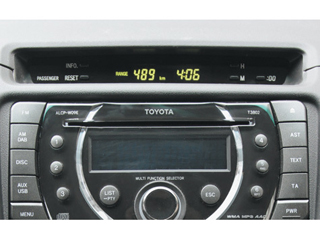
The superstructure over the central console with a single-line display in the price lists is called a multifunctional monitor. This is an option! Although in general, there is a little sense from her.
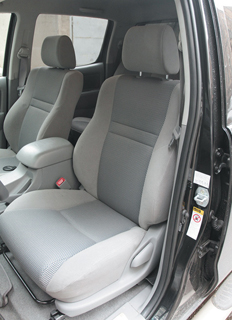
The front seats provide an acceptable level of comfort. But we are only talking about comfort: with lateral support, obvious problems are the car is quite strong and with peak loads of the pillow it is simply not able to withstand human weight.
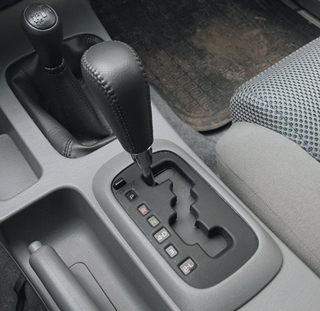
After restyling, the Japanese put a five -speed machine in Hilux. In principle, he does not represent anything supernatural from himself, but paired with a 3-liter turbodiesel with his duties completely decently.
But this is on the highway. Turn off him, and at first you are horrified from what for some four snow months a mixture of bitumen and stones called asphalt is turning into for some reason, and then from the behavior of the car. No, in general it is not bad, but for some reason terribly unstable. Even the Japanese have not yet come up with anything reliably and non-enabled springs, therefore, knowing that under the body a set of curved sheets, you are at least morally ready for the fact that each more or less serious pothole passed at medium speed is accompanied by a characteristic jump. But why do front pendants, meanwhile, are trying to portray something like the dance of St. Witt, and not to the beat, but to the anti -income to the oscillations of the rear axle? Judging by the assurances of Japanese engineers, during the restyling, they were just engaged in the optimization of the work of the corresponding nodes. I'm afraid they didn’t succeed. For some reason, I remember that the condo torsion design of the model of the beginning of the 90s worked at least more logical than the current two-leaf. Yes, the car turned worse, sometimes tried to go for a walk in the strip, but when the wheel enters the hole, it did not shake in convulsions.
Vibro loading is generally one of the biggest problems of this pickupa (as, indeed, many others). When you start a in a number 4-cylinder turbodiesel, everything comes to life from the pedals and ending with the folding side. The car does not fall apart, almost does not rattle, but vibrates greatly. And he begins to vibrate even more when you are touching. And so on until you gain at least 20 km/h. However, having reached cruising speed, you are again faced with the already described problem

The capacity of the cargo compartment is difficult to overestimate: in fact, the possibilities of pickups here are limited only by dimensions and nominal carrying capacity. But, oddly enough, it is better to refuse the kung. Firstly, he terribly rattles on the go, and secondly, already terrible visibility falls to almost zero. Well, thirdly, he has a separate key, which is extremely inconvenient.
The same Volkswagen Amarok, for example, is perceived on the asphalt more driver. It also shakes it on idle, but the quality of the asphalt move here is an order of magnitude better. At least, knowing that he has a completely non -picapa anterior suspension in stiffness, and the Heavy Duty version reinforced by a pair of extra sheets of feed (the first opportunity) flies into the stratosphere, the driver can predict his behavior in almost any situation. Alas, Toyota, alas, must be adapted in each case. And also force yourself not to put pressure on the gas, depicting the Australian farmer.
 For him, this car is the limit of dreams. Firstly, constructively, it is not more complicated than an ax or, say, an ice ax. Secondly, he is equally hope (at least in theory). That is, if you do not set the goal of killing Hilux in the first six months of operation, it will stand on a joke in two hundred years, and then because oil will end on Earth. Everything else is not a barrier for him. According to the intersection, this car literally rushes like a tank. At low speeds, the suspension is already without much difficulty damped everything that they can swallow. And the drive with a full set of options allows you to worry only about the adhesion properties of the tires. That is, under you is again a rather reliable and obedient car, calmly and confidently crawling both by virgin lands and the rut
For him, this car is the limit of dreams. Firstly, constructively, it is not more complicated than an ax or, say, an ice ax. Secondly, he is equally hope (at least in theory). That is, if you do not set the goal of killing Hilux in the first six months of operation, it will stand on a joke in two hundred years, and then because oil will end on Earth. Everything else is not a barrier for him. According to the intersection, this car literally rushes like a tank. At low speeds, the suspension is already without much difficulty damped everything that they can swallow. And the drive with a full set of options allows you to worry only about the adhesion properties of the tires. That is, under you is again a rather reliable and obedient car, calmly and confidently crawling both by virgin lands and the rut That's what I would never do was this car, living in the city. Firstly, 90% of the time you will carry air in the back. In extreme cases, a couple of containers of various garbage. Secondly, even surrounded by, it would seem, like the size of SUV driving Hilux you feel like a sifting elephant. That is, it seems to turn well, when turning, it fits into three standard stripes, but any attempt to park along the road is equal to the feat, since even if you find a suitable hole next to the curbs (into which the car carrot with smarts will fit), looking back, you will see And you will not see anything except the skeleton of sun rays that are breaking through the glass. With the same success, the body cover can be made all -metal, and use the salon mirror as a make -up. I suppose that the driver of a career dump truck feels about the same way, but it is even more difficult to meet him in the center of Moscow than a dinosaur.
In other words, buying Hilux, be prepared for the fact that, being within large settlements, you will not fully get pleasure from it. The city is another matter, and it is better if it is not a track, but a field. Since, unlike the Amarok already mentioned here, this is not a car for active pastime, but a real workhorse that should deliver a certain amount of cargo from one point of space to another, and it does not matter to her on the way of the road

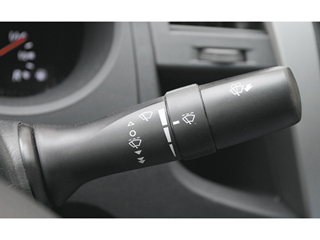

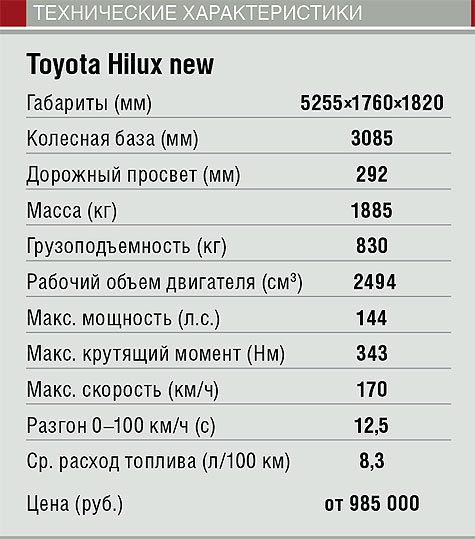
Certificate MK
In the pickup class, the Japanese continue to lead with a huge margin. The only one who was able to dilute the hegemony is VW Amarok. But for starters, he had to participate in the Dakar rally, and then collect a decent collection of awards around the world. However, for us this was not enough in the first quarter of this year, the Germans did not reach up to 350 copies sold. In the first place, the Mitsubishi L200, which overlap this result is more than three times. However, it is not worth racking your head over the reasons: despite the average price tag, the initial VW of the rear -wheel drive. Unlike Mitsubishi and Toyota.
Competitors
German wolf
In principle, Amarok is not a pickup in the traditional sense. VW did everything so that on world platforms this car is perceived not as a farm truck, but as a car for active pastime. Nevertheless, technically, it is not much different from most competitors. He has a spar hard frame, springs in the rear bridge, a good turbodiesel and a connected four -wheel drive. Even the price tag is not bad from 987 100 rubles. The only problem is the initial Amarok rear -wheel drive, while the same Toyota and L200 AWD systems are equipped even in the database.
Big Kush
A very worthy exterior, an honest all -wheel drive, a complete set of off -road systems, a good turbodiesel, and recently an automatic machine is a very decent set for any SUV, nevertheless, the reasons for the popularity of Mitsubishi L200 are primarily hidden in its cost. Today, 699,000 rubles are asked for a car in the basic configuration, so it is more than 100,000 rubles cheaper than the closest competitor to Mazda BT-50. In general, Toyota, while maintaining the current price, will not cope with it in any case.
Fun Club
Nissan Navara was not the first pickup in the Russian market. However, he became the first pickup, which was originally positioned as a car for outdoor activities. Actually, that's why Navara never cost cheaply. Its initial price today is 1.28 million rubles, to which more than half of such machines do not reach in principle. But at the same time, few of the competitors can offer the buyer, for example, parking sensors, a rear view camera or a standard navigation system.
Source: MKOMBILA magazine [May/2011]

.jpg)
.jpg)
.jpg)
.jpg)
.jpg)

